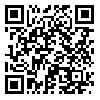Volume 8, Issue 4 (12-2005)
J Arak Uni Med Sci 2005, 8(4): 23-30 |
Back to browse issues page
Download citation:
BibTeX | RIS | EndNote | Medlars | ProCite | Reference Manager | RefWorks
Send citation to:



BibTeX | RIS | EndNote | Medlars | ProCite | Reference Manager | RefWorks
Send citation to:
Zamanzad B, Shirzad H A, Naseri F. Comparison of the causative bacteria and antibacterial susceptibility pattern of nosocomial and community- acquired urinary tract pathogens in 13-35 years old women, Shahrekord, 2004. J Arak Uni Med Sci 2005; 8 (4) :23-30
URL: http://jams.arakmu.ac.ir/article-1-265-en.html
URL: http://jams.arakmu.ac.ir/article-1-265-en.html
1- , Bzamanzad@yahoo.com
Abstract: (28072 Views)
Introduction: Treatment of urinary tract infections(UTIs), as one of the most common nosocomial and community acquired infections, has remained an important medical problem. Differentiation between susceptibility patterns of nosocomial and community acquired pathogens is important epidemiologically and helps the administration of appropriate antimicrobial drugs. The goal of this study was isolation of the most common causative bacteria, in two groups of 13-35 years old women in Shahrekord city within 6 months period(April-September 2004). Also, the resistance patterns of common isolated organisms in these two groups were compared. Materials and Methods: This is an analythical-cross sectional study. 100 urine samples from women aged 13-35 years old hospitalized in different wards of Hajar and Kashani hospitals(group one) with positive urine cultures were obtained performing clean-catch midstream method. Also 100 urine samples from 13-35 years old women with positive urine culture and acute UTI symptoms from Shahrekord private laboratory (group two) were obtained. The most common causative bacteria in the two groups and the antibacterial sensitivity patterns of isolated organisms were evaluated. Data was analysed using T test. Results: Totally, the most common nosocomial UTI pathogens were E.coli, Klebsiella spp., Staphylococcus saprophyticus, Pseudomonas and Enterobacter spp. In group two, E.coli, Klebsiella spp., Enterobacter spp., Proteus, Staphylococcus saprophyticus and Citrobacter spp. were isolated predominantly. The highest bacterial resistance rate belonged to Ampicillin and Co-trimoxazole. Antibiotics useful in treatment of nosocomial UTI were Ceftizoxim, Nitrofurantoin, Nalidixic acid, Cephalothin and Gentamicin respectively. Nitrofurantoin, Nalidixic acid, Ceftazidim, Gentamicin and Cephalothin were the most effective antibiotics in community acquired UTIs. Conclusion: The emergence of pathogens with alarming rates of resistance, highlights the need for a more rationalized and restricted use of antibiotics in order to minimize the spread of resistant bacterial strains.
Subject:
General
Received: 2009/03/12
Received: 2009/03/12
Send email to the article author
| Rights and permissions | |
 |
This work is licensed under a Creative Commons Attribution-NonCommercial 4.0 International License. |





